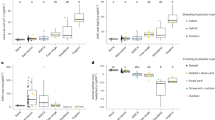Abstract
A NUMBER of workers have compared the general performance of domestic ruminants with and without ciliate protozoa. In no case was any striking difference observed. Hungate1 has suggested that bacteria may take over the activities of the normal ciliate protozoan population, and also Bryant and Small2 observed a distinct drop in the count of cellulolytic bacteria in two unfaunated calves after they had been inoculated with whole rumen contents containing protozoa. Biochemical work also suggests that the bacteria and ciliate protozoa digest similar substrates.
This is a preview of subscription content, access via your institution
Access options
Subscribe to this journal
Receive 51 print issues and online access
$199.00 per year
only $3.90 per issue
Buy this article
- Purchase on Springer Link
- Instant access to full article PDF
Prices may be subject to local taxes which are calculated during checkout
Similar content being viewed by others
References
Hungate, R. E., Ann. Rev. Microbiol., 4, 53 (1950).
Bryant, M. P., and Small, N., J. Dairy Sci., 43, 654 (1960).
Becker, E. R., and Everett, R. C., Amer. J. Hyg., 11, 362 (1930).
Nottle, M. C., Austral. J. Biol. Sci., 9, 593 (1956).
Author information
Authors and Affiliations
Rights and permissions
About this article
Cite this article
EADIE, J., HOBSON, P. Effect of the Presence or Absence of Rumen Ciliate Protozoa on the Total Rumen Bacterial Count in Lambs. Nature 193, 503–505 (1962). https://doi.org/10.1038/193503a0
Issue Date:
DOI: https://doi.org/10.1038/193503a0
This article is cited by
Comments
By submitting a comment you agree to abide by our Terms and Community Guidelines. If you find something abusive or that does not comply with our terms or guidelines please flag it as inappropriate.



